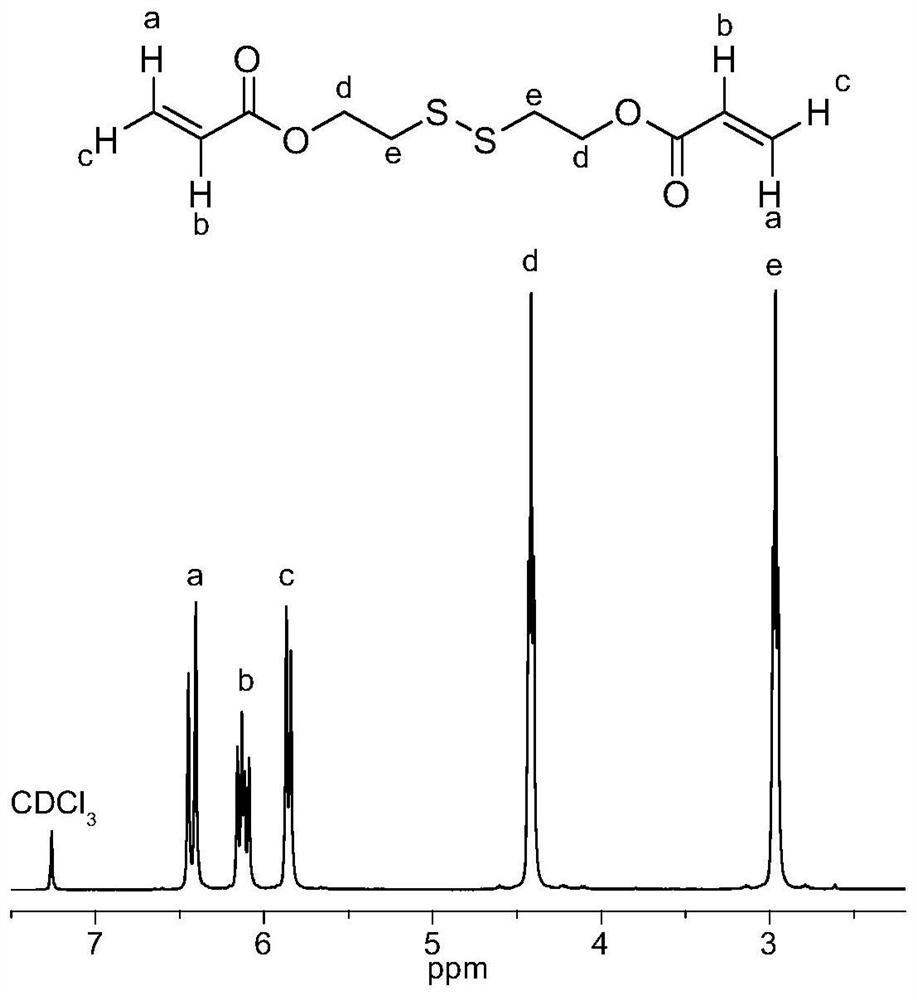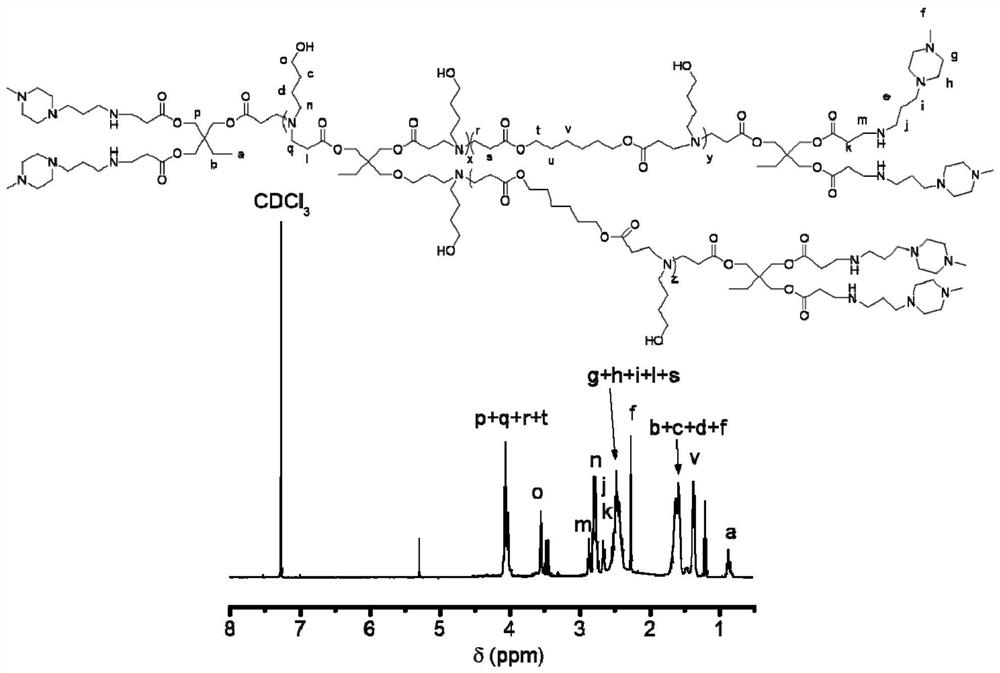Reduction-responsive hyperbranched poly-beta-amino ester with efficient gene delivery capability and preparation method and application thereof
A technology of hyperbranched polyaminoester, which can be used in medical preparations without active ingredients, medical preparations containing active ingredients, gene therapy, etc., can solve problems such as high cytotoxicity, improve endocytosis efficiency, positive charge The effect of high density and rapid degradation
- Summary
- Abstract
- Description
- Claims
- Application Information
AI Technical Summary
Problems solved by technology
Method used
Image
Examples
Embodiment 1
[0064] The method for preparing reduction-responsive hyperbranched poly-β-amino esters is as follows:
[0065] Bis(2-hydroxyethyl)disulfide (7.7 g, 50 mmol) and triethylamine (18.75 mL, 150 mmol) were dissolved in 200 mL of anhydrous tetrahydrofuran (THF). Under nitrogen protection, a solution of acryloyl chloride (12.2 mL, 150 mmol) in anhydrous THF (50 mL) was added dropwise within 2 h, and reacted at room temperature for 24 h. Na 2 CO 3 Solution (0.2 M, 5 × 100 mL) and distilled water (3 × 100 mL) were washed separately, dried over anhydrous magnesium sulfate, and the solvent was removed by rotary evaporation. The crude product was subjected to silica gel column chromatography (developing solvent: n-hexane / ethyl acetate = 16 / 1, v / v) to give 2,2-dithiodiethanol diacrylate (SSDA) (8.1 g, 31 mmol, yield 62%) as a pale yellow oil. Deuterated chloroform for NMR, with figure 1 its NMR spectrum.
Embodiment 2
[0067] 2,2-Dithiodiethanol diacrylate (217 mg, 0.83 mmol), trimethylolpropane triacrylate (TMPTA, 74 mg, 0.25 mmol) and 4-amino-1-butanol (89 mg, 1 mmol), reacted at 50°C for 16 hours under solvent-free conditions. Add 1-(3-aminopropyl)-4-methylpiperazine (MPZ, 157 mg, 1 mmol) in dichloromethane solution (1 mL), and react at room temperature for 12 h. Then it was settled three times with diethyl ether, and the solvent was removed under vacuum to obtain a yellow viscous oil, namely BPAE-SS, with a yield of 90%. Deuterated chloroform for NMR, with figure 2 its NMR spectrum. The chemical structural formula of BPAE-SS (x is 9-11, y is 8-10, z is 7-9) is as follows:
[0068]
[0069] The above reaction at 50°C for 16 hours was replaced with reaction at 60°C for 8 hours, and the rest remained unchanged to obtain BPAE-SS with a yield of 75%.
Embodiment 3
[0077] Example 3 Preparation, Characterization and Application of Nanomedicine Packing siRNA
[0078] Prepare respectively the poly-β-amino ester (BPAE-SS) concentration of 1 mg / mL acetate buffer solution (pH = 5.2) and the DEPC aqueous solution of ICAM-1 siRNA (siICAM-1) concentration of 0.1 mg / mL in Example 2 ; then poly-β-amino ester and siRNA were mixed in different weight ratios (10 / 1, 20 / 10, 30 / 1, 40 / 1, 50 / 1, 80 / 1 and 100 / 1), and the mixture was vortexed for 10 seconds, and then incubated at 37 °C for 30 min to form a poly-β-amino ester / siRNA complex (BPAE-SS / siRNA). Then add 2% agarose gel electrophoresis to the sample well, run at 90 V for 20 min, and image with the gel imaging system to measure the loading efficiency of siRNA.
[0079] The particle size and potential of the polyβ-amino ester / siRNA complex under different weight ratio conditions were determined by dynamic light scattering (DLS).
[0080] Poly-β-amino ester was pretreated with glutathione (GSH, 5 mM, ...
PUM
| Property | Measurement | Unit |
|---|---|---|
| particle diameter | aaaaa | aaaaa |
| particle diameter | aaaaa | aaaaa |
Abstract
Description
Claims
Application Information
 Login to View More
Login to View More - R&D
- Intellectual Property
- Life Sciences
- Materials
- Tech Scout
- Unparalleled Data Quality
- Higher Quality Content
- 60% Fewer Hallucinations
Browse by: Latest US Patents, China's latest patents, Technical Efficacy Thesaurus, Application Domain, Technology Topic, Popular Technical Reports.
© 2025 PatSnap. All rights reserved.Legal|Privacy policy|Modern Slavery Act Transparency Statement|Sitemap|About US| Contact US: help@patsnap.com



